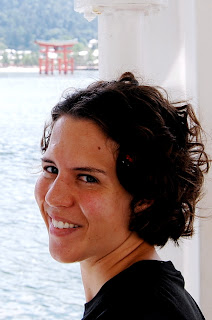 From Beijing, Joe and I took an overnight train to Xi'an, home to the famous Terracotta Warriors. Hate to say it, but Xi'an was probably the low point of our trip. While we enjoyed some of the sights there, worries about safety definitely put a damper on our stay.
From Beijing, Joe and I took an overnight train to Xi'an, home to the famous Terracotta Warriors. Hate to say it, but Xi'an was probably the low point of our trip. While we enjoyed some of the sights there, worries about safety definitely put a damper on our stay.We splurged on a private room on the train, which was nice for the privacy, but despite paying a premium for the pleasure the air conditioning was broken and the beds hard as rock.
The moment we got off the train, locals started aggressively hounding us to trade our old train ticket for an English map. When we refused, they offered to buy it from us — most likely so they could attempt to later resell it to unsuspecting tourists at a "discount." Probably our first clue that this place was a little shady.
Once we'd checked in to our hostel we struck out to find some lunch, only to have one of the desk clerks hurry out the front door and chase us down to issue a warning: Best to wear your backpack on your front and keep your hands on your camera at all times, he told us. The pickpockets are very slick and will open your bags and swipe your things before you know it. A couple weeks earlier, another hostel guest had had his camera stolen off his body.
Needless to say, this left us feeling a little unsettled. A short time later we stopped in the bank to exchange some currency, and Joe set his SLR camera on the counter next to him. When the bank employee spotted it he gasped a little as though he was surprised to see someone carrying nice electronics and told Joe "Oh, sir, be careful of your belongings!" Our discomfort grew.
Consulting our Lonely Planet as we began sightseeing, we again saw a note warning that Xi'an is notorious for its pickpockets. And again, walking in an underground passage beneath a busy intersection, we saw signs on the wall warning us to watch our belongings — in only English. By this point Joe's paranoia was spinning in overdrive. Every time he saw people looking at us he worried that they weren't just looking out of curiosity, but to determine whether they could steal something.
That made it hard to relax, but we tried to enjoy what we could.
The Terracotta Army of course was the main draw and the reason we made the jaunt to Xi'an. Some history (thanks to Wikipedia): Back around 210 B.C., the first emperor of China took the throne and ordered the construction of the Terracotta Army and his mausoleum. Around 700,000 workers were enslaved to construct the army, which included some 8,000 warriors as well as chariots, horses, officials, acrobats, strongmen and musicians. This army was supposed to help the emperor rule another empire in the afterlife.
These warriors are life size and generally stand around 6 feet tall, with each having unique facial features and even different hair styles and uniforms depending on each soldier's rank.
They were discovered by some farmers in 1974 and excavation continues to this day. It is considered one of the most famous archaeological finds in the world.
I enjoyed seeing this but I have to be honest; I was a tad disappointed. It seemed a little over-hyped to me. I expected something that would really take my breath away, but it wasn't quite that imposing. But still really interesting nonetheless.
Probably my favorite part of Xi'an besides the Terracotta Army was the Muslim Quarter, where we went first to eat some lunch and ended up sampling several Muslim treats as well as some gyouza (Chinese dumplings). Many gastronomic delights.
Numerous roadside vendors were selling a selection of dried fruit, cheap, colorful and delicious.
crap
treasure
shoes
toys
books












